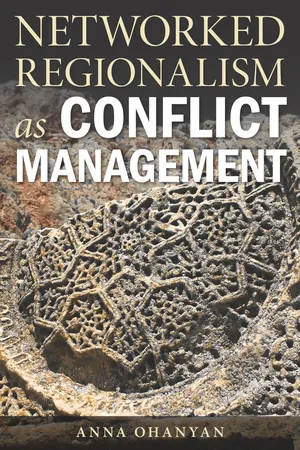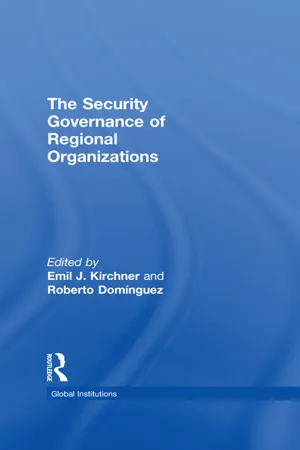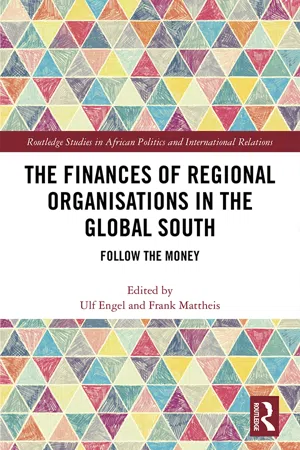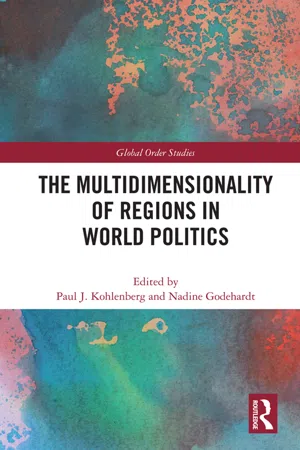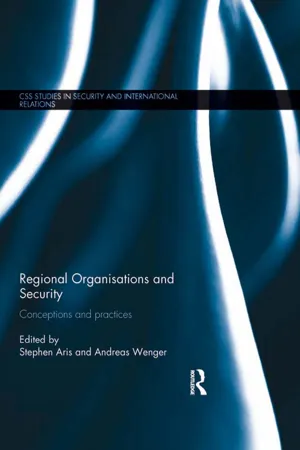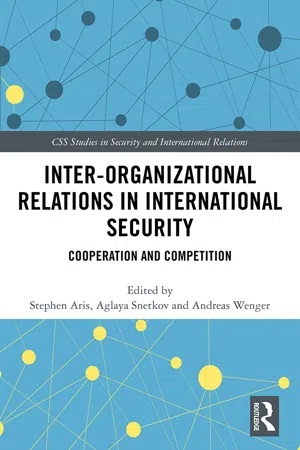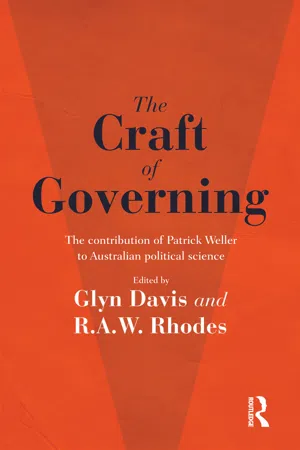Politics & International Relations
Regional Organisations
Regional organizations are intergovernmental bodies formed by countries within a specific geographic area to address common issues and promote cooperation. They can focus on economic, security, political, or social objectives and often provide a platform for member states to discuss and coordinate policies. Examples include the European Union, African Union, and Association of Southeast Asian Nations (ASEAN).
Written by Perlego with AI-assistance
Related key terms
8 Key excerpts on "Regional Organisations"
- eBook - ePub
- Anna Ohanyan(Author)
- 2015(Publication Date)
- Stanford University Press(Publisher)
Geography matters in such areas as a source of conflict and a factor in insecurity. Territory is also often a factor in the solution in peace-building efforts. As I argue later in this chapter, international organizations with specialized agencies for peace building and governance often develop aid packages for whole regions as opposed to countries. The country offices of these organizations regularly share best practices and coordinate their programmatic efforts. At least externally, geography and territory emerge as important regional markers for international organizations and multilateral aid agencies. The key characteristic of regions in politically divided areas is the cohabitation of integrative and fragmenting forces. The lack of a shared identity in PDAs and intense nation-building processes often emerge in the presence of the more subtle integrative forces from the economic sector. The theoretical tools need to reflect this duality. Two working definitions of regionalism are proposed in this study, specifically developed for PDAs. Under the first definition, a region in a PDA is a system of geographically proximate states with deep security and economic interdependencies, but one that may not broadly be seen as a region from the respective populations in the member countries yet receives strong recognition as a region by outside actors. Such regions also possess a layer of international institutions engaged in state-building and region-building projects of various sorts. Such regions are characterized by a weak cross-border interface and yet are open to international actors for state-building purposes or are vulnerable to external power penetration. Often, having weak governance/administrative structures and poorly consolidated democratic institutions, states in a politically divided region have functional ties that are embryonic and uneven - Emil J. Kirchner, Roberto Dominguez(Authors)
- 2013(Publication Date)
- Routledge(Publisher)
et al. 2004; Kirchner 2006; Kirchner and Sperling 2007), can be successfully applied to other international/regional organizations. Fifth, a larger and more diverse group of organizations gives greater scope to the exploration of historical and/or geopolitical factors as determinants of cooperation within organizations and with regard to external activities of regional organizations, i.e. whether the domestic factors of regional organizations facilitate or inhibit regional or global security governance (Kirchner and Sperling 2010).There are some difficulties in delineating geographic regions, particularly when membership and remits of organizations are considered (see Table 1.1 ). While certain organizations like the AU and the EU have a strictly regional constituency, other organizations such as the OAS, the OSCE, NATO and the SCO draw their membership from different regions, if not continents. In contrast, some organizations, like Mercosur or the Andean Community of Nations, have a more sub-regional perspective. Furthermore, the remit or declared geographic focus of attention might confine a certain organization to a specific region while consisting of members from different regions or continents. This is the case largely with regard to the OAS and the OSCE and was for a long time the situation with regard to NATO. There is hence a considerable overlap between regional and international organizations in both conceptual and empirical terms.Table 1.1 Members of regional organizations (January 2011)Crucial to the examination is the attempt to explore how organizations with different tasks and profiles perform across the four security dimensions, i.e. how organizations which were established with a distinct security perspective such as NATO and the OSCE compare in performance with those which were originally formed with a pronounced economic vocation, such as Mercosur. To ensure comparability in the assessment of the 10 organizations a common framework has been adopted which systematically traces developments in organizational goals and institutional innovations and in performance across four security dimensions. The data collection is based on official documents, secondary sources and, for some organizations, interviews with officials.- eBook - ePub
The Finances of Regional Organisations in the Global South
Follow the Money
- Ulf Engel, Frank Mattheis, Ulf Engel, Frank Mattheis(Authors)
- 2019(Publication Date)
- Routledge(Publisher)
7 In terms of thematic areas, we give particular attention to Regional Organisations that are active in the field of peace and security. This field fits with our conceptual and thematic ambitions: it is of particular importance in many countries of the Global South (for an overview, see HIICR 2018), entails comparatively costly and visible expenditures, and often requires some form of centralised institutionalisation (Peck 1998; Haftel and Hofmann 2017). Most of our cases are not exclusively or even predominantly security organisations, but they dedicate parts of their efforts to this field. Although traditional, military concerns of state security are sometimes avoided due to sovereignty concerns of member states, all organisations include some provisions for regional security, be it, for example, a defence council in South America (Weiffen, Wehner and Nolte 2013) or disaster management in Southeast Asia (Tercovich 2019). We therefore highlight the activities of Regional Organisations related to peace and security in order to deepen our analysis. Where the data allow, we assess the situation of security budgets in addition to the general budget.The finances of Regional Organisations
Some scholars have shown interest in how Regional Organisations respond to a financial crisis affecting their member states (Pempel and Tsunekawa 2015), but a closer look at the financial crisis of the organisations themselves is still missing. Studies that dissect one particular RO (for instance, on the Southern Common Market [MERCOSUR], cf. Franca Filho et al. 2010; Gardini 2010; Gómez-Mera 2013) usually inform readers about the size of its budget and the challenges and disputes relating to it. Most of the time, however, the existence of a central budget is taken for granted. In this interpretation, the creation of a new organ within a RO, such as a court or a parliament, or even the creation of an entire RO, is primarily a matter of political will, of regional leadership, or of an emerging problem that warrants a regional response. The question of finances is implicitly subsumed but not tackled upfront. The neglect of regional development banks as objects of study in regionalism studies further underlines the point that finances have been an overlooked topic.Notwithstanding, we note a recent surge of academic interest in regional development banks from a political economy perspective (cf. Park and Strand 2015; Ben-Artzi 2016; Palestini 2016). Even though comparative perspectives remain scattered, this interest opens up future perspectives based on how regional development banks affect regionalism through their financial capacities, which converge with this book’s concentration on the finances of ROs. That being said, regional development banks play a secondary role in our book as they tend to focus on financing decentralised programmes, such as transnational infrastructure, rather than directly contributing to formal ROs. - eBook - ePub
Comparative Regionalisms for Development in the 21st Century
Insights from the Global South
- Timothy M. Shaw, Emmanuel Fanta(Authors)
- 2016(Publication Date)
- Routledge(Publisher)
Chapter 12 Regional Formations and Global Governance 1 Luk Van Langenhove and Maria Cristina Macovei This chapter aims to provide a framework for understanding the growth and changing character of regional governance. Section one explores how governance has evolved from an essentially state-led pre-occupation into a complex phenomenon that involves many other actors and that is characterized by inter-linkages between different (geographical) levels of policy-making. It will be argued that we are witnessing the transition from a single world of states towards a multiple world of states and regions. Important actors in this new world order are the world regional organizations and regional arrangements between states that have resulted from regional integration processes. Section two discusses three main varieties of regional integration that currently exist. First, there is the regional integration by removing economic obstacles, a process that has resulted in a multitude of regional trade arrangements all over the world. Second, there is the regional integration by building institutions and regulations that often go beyond economic and trade policies and that can be described as a ‘pooling’ of sovereignty at a transnational level. Third, there is regional integration by building a geopolitical identity and actorness. Here the ‘world region’ 2 behaves as an actor on the global scene, both through its own ‘foreign’ policy and through its presence in global institutions. The final section will then begin the exploration of the consequences of these varieties of regionalism for social policy. It will be argued that regionalism aimed at only creating free trade areas can put severe pressures on existing national social policies of the countries involved. On the other hand, the development of a broader and deeper form of regionalism (often referred to as ‘new regionalism’) can act as a driver towards regional social policies - Paul J. Kohlenberg, Nadine Godehardt, Paul J. Kohlenberg, Nadine Godehardt(Authors)
- 2020(Publication Date)
- Routledge(Publisher)
Whereas (economic) geographers typically recognise the region as a sub-state category (whether as a region per se, city-region or network of city-regions, etc.), in the context of new regionalism, the spatial referents of IR scholars are typically macro-regional – normally supra-state entities. Söderbaum (2003, 6) makes a distinction between micro-, meso- and macro-regions. Micro-regions are sub-state or cross-border regions (the latter cross the borderlines between domestic and international), meso-regions are mid-range state or non-state arrangements/processes and macro-regions are wider world regions. IR scholars also investigate spatial forms of governance and the roles of civil society in shaping and building large-scale regional governance structures in a globalising world (Söderbaum 2003; Fiaromonti 2014). For Von Hlatky (2013, 285), regionalism means cooperation between regional partners through the creation of multilateral regional institutions. Regionalisation for her is a product of bottom-up sociopolitical processes, which are tied to notions of identity. In political practice, regionalisation is often seen as a strategy of the state to delegate specific state functions and institutions to sub-state regions. Katzenstein (2005) argues in his “A World of Regions” that globalisation and internationalisation create open or porous regions. This relational perspective seems to prevail also in the theoretical debates on regions and on the regional system itself.Globalisation and accompanying claims about increasing economic competitiveness have also given rise to a number of new categories and spatial frameworks. Megaregion, resonating with new regionalist tendencies, is one such example (Ross 2009). Megaregions have a relational tuning and mesh with the fact that the contemporary world harbours about 300 city-regions with populations exceeding one million and at least 20 city-regions with populations of ten million or more. Megaregion is the name given to one or a grouping of several urban areas that are linked by social, economic, demographic, environmental and cultural ties. Such entities are formed into networks so that actors can make infrastructure and planning decisions. By definition, they are “networks of metropolitan centres and their surrounding areas” (Ross 2009, 1). Megaregions are seen by many scholars today as “the underlying driving forces of the world-economy” (Ross 2009, 6). Harrison and Hoyler (2015, 4) have argued that “megaregions are the latest episode in the long-running political-economic drama that is the search for a post-national spatial/scalar fix for globalised capital accumulation and organising (inter)national space economies”. At the same time these scholars are ambivalent about the overdetermined use of this idea and suggest that the concept itself should be critically scrutinised rather than being accepted as a taken-for-granted, self-explanatory category.- eBook - ePub
Regional Organisations and Security
Conceptions and practices
- Stephen Aris, Andreas Wenger(Authors)
- 2013(Publication Date)
- Routledge(Publisher)
Therefore, as already suggested, most ROs serve a security articulators or facilitators, rather than as independent regional security providers or actors. Most states are still reluctant to accept enforcement and solidarity provisions, such as the oversight of central institutional courts and bodies or the use of solidarity and collective defence commitments via treaties, within ROs. Kirchner and Domínguez outline that this isbecause it signals the erosion of sovereignty, despite the fact that some of the Regional Organisations already have instruments to suspend membership (AU, ECOWAS, OAS, SADC), enact sanctions (EU), use force to restore or keep peace (NATO) or collaborate in peacekeeping forces (AU, ECOWAS).23They note that the AU, via its enforced suspension of membership, has a reasonable degree of autonomy as an actor, but that ASEAN, MERCOSUR and the SCO have very little. Thus, ‘states remain largely autonomous from Regional Organisations’ interference in the enforcement of decisions and programmes’.24 Taking this into account, Kirchner and Domínguez assert that most ROs are focused on form setting (declaring goals/aims, setting norms) and coordinative (introducing/coordinating instruments) activities.25Security conceptions across Regional Organisations
At the level of declaratory policy and official documentation, the ROs assessed within this volume, outline conceptualisations of security that can be characterised, to varying extents, as embracing a widened agenda and deepened identification of referents. Yet, at the same time and to varying extents, the authors note that they also remain state-centric actors, and ultimately prioritise state and regime security as first-order priorities, in the realms of both traditional agendas of interstate relations, and non-traditional agendas of transnational and non-state threats. Furthermore, although they all tend to use similar language and terminology, drawn from a reading of the global context, to define their conceptions of security, often the meanings and significance ascribed to, and which emerge from, this script and its utility are different between ROs. Thus, the negotiation and contestation between the interpretation, adoption and usage of the global script within regional contexts is an important shaping dynamic for the conceptions of security within a RO. - eBook - ePub
Inter-organizational Relations in International Security
Cooperation and Competition
- Stephen Aris, Aglaya Snetkov, Andreas Wenger, Stephen Aris, Aglaya Snetkov, Andreas Wenger(Authors)
- 2018(Publication Date)
- Routledge(Publisher)
The character of what has originally been labeled “regional arrangements” has changed significantly since the adoption of the UN Charter. The term “regional arrangement” has almost disappeared and the term “regional organizations” is used instead. Whereas the term “regional arrangement” primarily referred to mutual assistance or defense agreements and other temporary and little-institutionalized arrangements, the term “regional organizations” refers to more institutionalized and stronger regional organizations with wider objectives. Such organizations were established when the international system underwent two regionalist turns after 1945. The first wave took place in the 1950s and 1960s, when organizations like the predecessors of the AU and the EU, the Organization of African Unity and the European Economic Community were established. The second wave swept over the globe in the aftermath of the Cold War and created, reignited or strengthened most of today’s regional organizations, including the EU, the AU but also sub-regional organizations such as the Economic Community of West African States (ECOWAS) and the Southern African Development Community (SADC) (Mansfield and Milner, 1999; Börzel, 2011).Weiss et al. (2007) argue that successful collective security depends on consensus, commitment, and organization. Even if consensus on how to deal with a security problem is reached and commitment of the relevant actors is given, “agreed-upon mechanisms, rules, and procedures must exist for carrying out a course of action” (Weiss et al., 2007, p. 7). As long as regional organizations lacked such mechanisms – and were unable to develop them during the Cold War – they were inadequate partners for the UN to assist in crisis management. Coexistence, viewed herein as the side-by-side existence without major coordination and overlap of mandates thus describes the UN-regional relations during the Cold War period when regional organizations “were frequently little more than bystanders to unfolding international events” (Barnett, 1995, pp. 411–412; also see Claude, 1959, p. 122).The end of the Cold War brought a significant change. Whereas the first-wave-organizations had few security-related objectives, the second-wave-organizations have much wider mandates, often covering security questions. Regional organizations have established institutions and mechanisms to effectively manage crises in their regions and sometimes beyond (“out-of-area”). Furthermore, several regional organizations, tried to become more autonomous and self-sustaining, aiming for leading roles in several policy fields, including security policy. The Association of South East Asian States, the ECOWAS, and the AU are three examples for this, each aiming to autonomously deal with crises in their regions. It was in this post-Cold War setting that Karl Deutsch’s “security community”-concept could witness a renaissance in academia. Security communities are considered as groups of states which have agreed to solve their disputes peacefully and have built trust among them (Deutsch, 1957; Adler and Barnett, 1998). - eBook - ePub
The Craft of Governing
The contribution of Patrick Weller to Australian political science
- R.A.W. Rhodes(Author)
- 2020(Publication Date)
- Routledge(Publisher)
For decades after 1945, the study of international organisations was something of a niche interest, or even a dead-end. There was a prevailing mood of scepticism about the ability of international bodies and treaties to restrain states’ supposedly primal drive to maximise power above all else, an attitude that reflected experience of the failure of the League of Nations in the 1930s, and the paralysis of the United Nations during the Cold War thanks to superpower rivalry. While there was some tradition of legal and descriptive analysis of international organisations, as well as a modest body of analysis of roll-call votes in the UN General Assembly, these bodies were mainly seen as talk shops, with the ‘real’ politics happening elsewhere. One leading international relations scholar rhetorically asked why anyone would study the puppets, i.e. international organisations, when they could be studying the puppeteers, i.e. states. The work that international organisations did outside of the security realm, exactly the sort at the centre of Weller and Xu’s studies, was too often seen as exemplifying distinctly unglamorous ‘low politics’, as opposed to the ‘high politics’ of war and peace. Though there were important and often quite brilliant individual exceptions, with scholars including Inis Claude, Ernst Haas, and Robert Cox and Harold Jacobson researching in this area, until the 1980s those studying international organisations in international relations were a very select group. The end of the Cold War, the stop-start progress of European integration, and the general growth in the prominence and number of international organisations transformed this situation and stimulated a massive expansion of scholarly interest in this area.Two strands of scholarship in particular are important in providing foils and points of departure for Weller and Xu’s work on international organisations. The first draws heavily on microeconomics, applying a rational choice framework to explain the relationship between states and the international organisations they form. The second draws loosely on Weber’s writings on bureaucracy and rational-legal authority, as well as more general theory from the humanities and sociology that has come to be termed ‘constructivist’.
Index pages curate the most relevant extracts from our library of academic textbooks. They’ve been created using an in-house natural language model (NLM), each adding context and meaning to key research topics.
